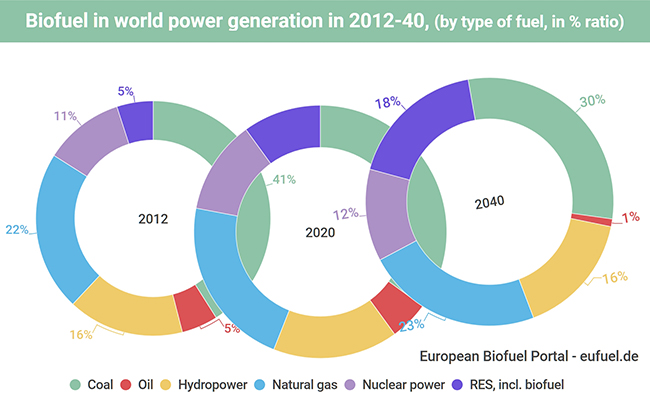Structure of world generation in 2012-40, (by type of fuel, in % ratio)

Dynamics of world output of electricity from RES 2012-40, (trillion KWh)
Main trends:
EIA (IEO2016): electricity is the fastest growing form of world's final energy consumption; net electricity generation will increase by more than 70% to 36.5 billion kWh by 2040.
IEA 2015: gradual reduction in the share of hydrocarbon raw materials in world generation: coal to 30% by 2040, (with an annual growth rate of 0.8% in 2012-2040).
IEA 2015: growth in the share of RES, including hydro and bioenergy, to 18% by 2040, (with an annual growth rate of 2.9% in 2012-2040); RES can become the world's largest source of electricity generation by 2040.
IEA: the share of energy derived from biofuel in TPES 5 has stably remained at around 10% (50 EJ) 6 since 2005 (according to REN21, in 2015 it was 14%). In total TPED 7 biomass was 16250 TWh (58.5 EJ).
REN21 2015: at the end of 2014, the share of RES, including hydropower and biofuel, accounted for 19.2% of total KPI8, with a share of "traditional biomass" of 8.9% and biofuel of 0.8%.
According to long-term scenarios for RES and biofuel:
EIA (IEO2016): in dynamics of world power generation in 2012-40 the expected increase in "green energy" will be 5.9 trillion kWh, where the share of biomass and waste will be 14% or 856 billion kWh.
IEA (2°C Scenario): bioenergy will increase to 160 EJ and will be 24% of
TPES by 2050.
Shell: by 2050 the share of biomass in TPES will be 15%: ˂50 EJ of them will be "traditional biomass", ≥50 EJ - first generation biofuel, up to 100 EJ - second generation biofuel.
According to IEA forecast, annual average growth rate of world biofuel market will amount to 5.87% in the period 2016-2020.
In 2013, according to Clean Edge, volume of world market of liquid biofuel (ethanol and biodiesel) was estimated at $ 97.8 billion, having increased by almost 6.5 times or by 550% since 2005. Its growth is expected to reach $ 178 billion by 2022.
